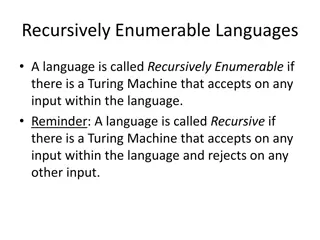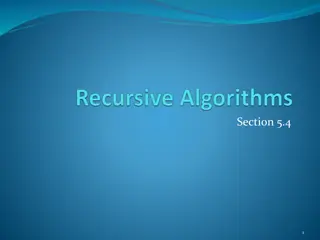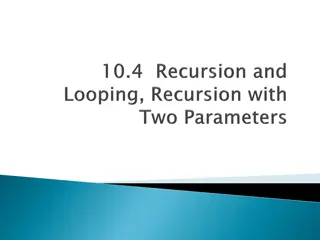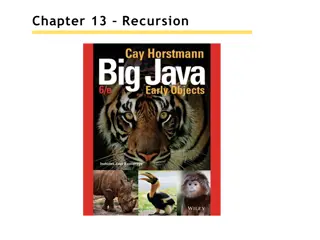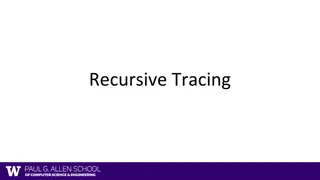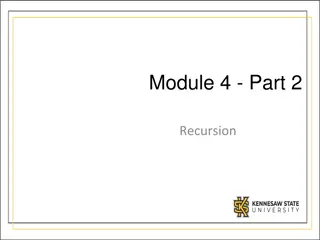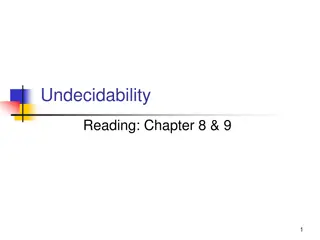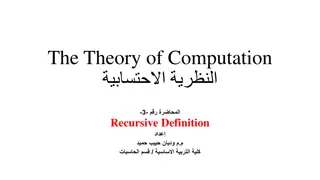Recursive Techniques for Summation
Delve into the world of recursion and linked lists with examples and solutions for summing elements both iteratively and recursively. Explore exercises and solutions for summing a list and a range of numbers, understanding base cases, and recursive implementations.
Download Presentation

Please find below an Image/Link to download the presentation.
The content on the website is provided AS IS for your information and personal use only. It may not be sold, licensed, or shared on other websites without obtaining consent from the author.If you encounter any issues during the download, it is possible that the publisher has removed the file from their server.
You are allowed to download the files provided on this website for personal or commercial use, subject to the condition that they are used lawfully. All files are the property of their respective owners.
The content on the website is provided AS IS for your information and personal use only. It may not be sold, licensed, or shared on other websites without obtaining consent from the author.
E N D
Presentation Transcript
Recursion and Linked Lists
Recursively sum a list Let's code this up recursively: def sum_nums(nums): """Returns the sum of the numbers in nums. >>> sum_nums([6, 24, 1984]) 2014 >>> sum_nums([-32, 0, 32]) 0 """ Docstrings typically would not specify whether an approach was recursive or iterative, since that is an implementation detail. However, we'll make it clear in assignments and exam questions.
Recursively sum a list (solution) def sum_nums(nums): """Returns the sum of the numbers in nums. >>> sum_nums([6, 24, 1984]) 2014 >>> sum_nums([-32, 0, 32]) 0 """ if nums == []: return 0 else: return nums[0] + sum_nums( nums[1:] ) When recursively processing lists, the base case is often the empty list and the recursive case is often all-but-the-first items.
Iteratively sum a range Let's code this up iteratively: def sum_up_to(n): """Returns the sum of positive numbers from 1 up to n (inclusive). >>> sum_up_to(5) 15 """
Iteratively sum a range (solution) Using the range type: def sum_up_to(n): """Returns the sum of positive numbers from 1 up to n (inclusive). >>> sum_up_to(5) 15 """ sum = 0 for i in range(1, n+1): sum += i return sum Remember that range(start, end) always ends right before end.
Recursively sum a range Now try it recursively: def sum_up_to(n): """Returns the sum of positive numbers from 1 up to n (inclusive). >>> sum_up_to(5) 15 """
Recursively sum a range (solution) Now try it recursively: def sum_up_to(n): """Returns the sum of positive numbers from 1 up to n (inclusive). >>> sum_up_to(5) 15 """ if n == 1: return 1 else: return n + sum_up_to(n-1)
Recursively reversing a string def reverse(s): """Returns a string with the letters of s in the inverse order. >>> reverse('ward') 'draw' """ Breaking it down into subproblems reverse("ward") = reverse("ard") + "w" reverse("ard") = reverse("rd") + "a" reverse("rd") = reverse("d") + "r" reverse("d") = "d"
Recursively reversing a string (solution) def reverse(s): """Returns a string with the letters of s in the inverse order. >>> reverse('ward') 'draw' """ if len(s) == 1: return s else: return reverse(s[1:]) + s[0] When recursively processing strings, the base case is typically an empty string or single-character string, and the recursive case is often all-but-the-first characters.
Helper functions If a recursive function needs to keep track of more state than the arguments of the original function, you may need a helper function. def fUnKyCaSe(text): """Returns text in fUnKyCaSe >>> fUnKyCaSe("wats up") 'wAtS Up' """ def toggle_case(letter, should_up_case): return letter.upper() if should_up_case else letter.lower() def up_down(text, should_up_case): if len(text) == 1: return toggle_case(text, should_up_case) else: return toggle_case(text[0], should_up_case) + up_down(text[1:], not should_up_case) return up_down(text, False)
Reversing a number def reverse_digits(n): """Returns n with the digits reversed. >>> reverse_digits(123) 321 """
Reversing a number (solution) def reverse_digits(n): """Returns n with the digits reversed. >>> reverse_digits(123) 321 """ def reverse(n, r): r *= 10 if n < 10: return r + n else: return reverse(n // 10, r + n % 10) return reverse(n, 0)
Recursion on different data types Data Type Base case condition Current item Recursive case argument Numbers == 0 n % 10 n // 10 L[1:] L[:-1] Lists == [] L[0] == '' len(S) == 1 S[1:] S[:-1] Strings S[0]
Why do we need a new list? Python lists are implemented as a "dynamic array", which isn't optimal for all use cases. Inserting an element is slow, especially near front of list. What happens if we have this list and want to insert Z at the front A Z B C D E F G Plus inserting too many elements can require re-creating the entire list in memory, if it exceeds the pre-allocated memory.
Linked Lists A linked list is a chain of objects where each object holds a value and a reference to the next link. The list ends when the final reference is empty. Value: X Next: Let's add Z to this list: Value: Z Next: Value: A Next: Value: B Next: Value: C Next: Value: D Next: Value: E Next: () Now let's add X after C Linked lists require more space but provide faster insertion*. * when we're already at the point of insertion.
A Link class class Link: empty = () def __init__(self, first, rest=empty): self.first = first self.rest = rest How would we use that? ll = Link("A", Link("B", Link("C"))) View in PythonTutor
A fancier LinkedList class Link: """A linked list.""" empty = () def __init__(self, first, rest=empty): assert rest is Link.empty or isinstance(rest, Link) self.first = first self.rest = rest def __repr__(self): if self.rest: rest_repr = ', ' + repr(self.rest) else: rest_repr = '' return 'Link(' + repr(self.first) + rest_repr + ')' def __str__(self): string = '<' while self.rest is not Link.empty: string += str(self.first) + ' ' self = self.rest return string + str(self.first) + '>'
Creating a range Similar to [x for x in range(3, 6)] def range_link(start, end): """Return a Link containing consecutive integers from start to end, not including end. >>> range_link(3, 6) Link(3, Link(4, Link(5))) """ if start >= end: return Link.empty return Link(start, range_link(start + 1, end)) View in PythonTutor
Exercise: Mapping a linked list Similar to [f(x) for x in lst] def map_link(f, ll): """Return a Link that contains f(x) for each x in Link LL. >>> square = lambda x: x * x >>> map_link(square, range_link(3, 6)) Link(9, Link(16, Link(25))) """
Exercise: Mapping a linked list (solution) Similar to [f(x) for x in lst] def map_link(f, ll): """Return a Link that contains f(x) for each x in Link LL. >>> square = lambda x: x * x >>> map_link(square, range_link(3, 6)) Link(9, Link(16, Link(25))) """ if ll is Link.empty: return Link.empty return Link(f(ll.first), map_link(f, ll.rest)) View in PythonTutor
Exercise: Filtering a linked list Similar to [x for x in lst if f(x)] def filter_link(f, ll): """Return a Link that contains only the elements x of Link LL for which f(x) is a true value. >>> is_odd = lambda x: x % 2 == 1 >>> filter_link(is_odd, range_link(3, 6)) Link(3, Link(5)) """
Exercise: Filtering a linked list (solution) View in PythonTutor Similar to [x for x in lst if f(x)] def filter_link(f, ll): """Return a Link that contains only the elements x of Link LL for which f(x) is a true value. >>> is_odd = lambda x: x % 2 == 1 >>> filter_link(is_odd, range_link(3, 6)) Link(3, Link(5)) """ if ll is Link.empty: return Link.empty elif f(ll.first): return Link(ll.first, filter_link(f, ll.rest)) return filter_link(f, ll.rest)
Linked lists can change Attribute assignments can change first and rest attributes of a Link. s = Link("A", Link("B", Link("C"))) s.first = "Hi" s.rest.first = "Hola" s.rest.rest.first = "Oi" View in PythonTutor
Beware infinite lists The rest of a linked list can contain the linked list as a sub-list. s = Link("A", Link("B", Link("C"))) t = s.rest t.rest = s s.first # 'A' s.rest.rest.rest.rest.rest.first # 'B'
Exercise: Adding to front of linked list Value: Z Next: Value: A Next: Value: B Next: Value: C Next: Value: D Next: Value: E Next: () def insert_front(linked_list, new_val): """Inserts new_val in front of linked_list, returning new linked list. >>> ll = Link(1, Link(3, Link(5))) >>> insert_front(ll, 0) Link(0, Link(1, Link(3, Link(5)))) """
Exercise: Adding to front of linked list (Solution) def insert_front(linked_list, new_val): """Inserts new_val in front of linked_list, returning new linked list. >>> ll = Link(1, Link(3, Link(5))) >>> insert_front(ll, 0) Link(0, Link(1, Link(3, Link(5)))) """ return Link(new_val, linked_list)
Exercise: Adding to an ordered linked list Value: 6 Next: Value: 1 Next: Value: 3 Next: Value: 5 Next: Value: 7 Next: Value: 9 Next: () def add(ordered_list, new_val): """Add new_val to ordered_list, returning modified ordered_list. >>> s = Link(1, Link(3, Link(5))) >>> add(s, 0) Link(0, Link(1, Link(3, Link(5)))) >>> add(s, 3) Link(0, Link(1, Link(3, Link(5)))) >>> add(s, 4) Link(0, Link(1, Link(3, Link(4, Link(5))))) >>> add(s, 6) Link(0, Link(1, Link(3, Link(4, Link(5, Link(6)))))) """ if new_val < ordered_list.first: elif new_val > ordered_list.first and ordered_list.rest is Link.empty: elif new_val > ordered_list.first: return ordered_list
Exercise: Adding to an ordered linked list (solution) def add(ordered_list, new_val): """Add new_val to ordered_list, returning modified ordered_list. >>> s = Link(1, Link(3, Link(5))) >>> add(s, 0) Link(0, Link(1, Link(3, Link(5)))) >>> add(s, 3) Link(0, Link(1, Link(3, Link(5)))) >>> add(s, 4) Link(0, Link(1, Link(3, Link(4, Link(5))))) >>> add(s, 6) Link(0, Link(1, Link(3, Link(4, Link(5, Link(6)))))) """ if new_val < ordered_list.first: original_first = ordered_list.first ordered_list.first = new_val ordered_list.rest = Link(original_first, ordered_list.rest) elif new_val > ordered_list.first and ordered_list.rest is Link.empty: ordered_list.rest = Link(new_val) elif new_val > ordered_list.first: add(ordered_list.rest, new_val) return ordered_list




